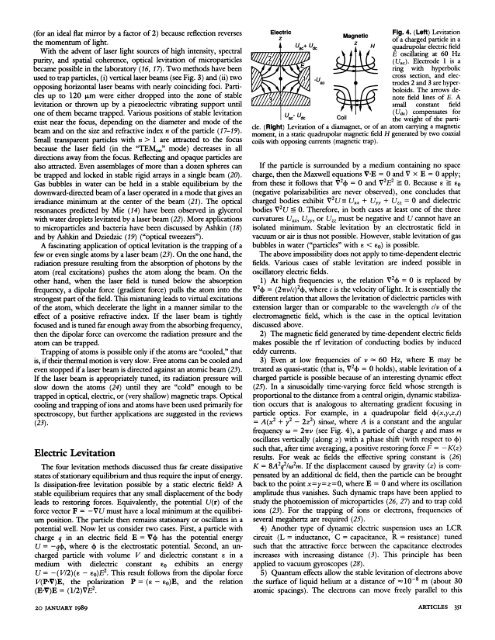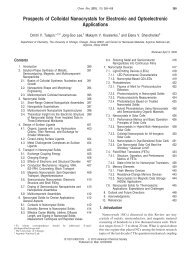Levitation in Physics
Levitation in Physics
Levitation in Physics
Create successful ePaper yourself
Turn your PDF publications into a flip-book with our unique Google optimized e-Paper software.
(for an ideal flat mirror by a factor of 2) because reflection reverses<br />
the momentum of light.<br />
With the advent of laser light sources of high <strong>in</strong>tensity, spectral<br />
purity, and spatial coherence, optical levitation of microparticles<br />
became possible <strong>in</strong> the laboratory (16, 17). Two methods have been<br />
used to trap particles, (i) vertical laser beams (see Fig. 3) and (ii) two<br />
oppos<strong>in</strong>g horizontal laser beams with nearly co<strong>in</strong>cid<strong>in</strong>g foci. Particles<br />
up to 120 ,um were either dropped <strong>in</strong>to the zone of stable<br />
levitation or thrown up by a piezoelectric vibrat<strong>in</strong>g support until<br />
one of them became trapped. Various positions of stable levitation<br />
exist near the focus, depend<strong>in</strong>g on the diameter and mode of the<br />
beam and on the size and refractive <strong>in</strong>dex n of the particle (17-19).<br />
Small transparent particles with n > 1 are attracted to the focus<br />
because the laser field (<strong>in</strong> the "TEMoo" mode) decreases <strong>in</strong> all<br />
directions away from the focus. Reflect<strong>in</strong>g and opaque particles are<br />
also attracted. Even assemblages of more than a dozen spheres can<br />
be trapped and locked <strong>in</strong> stable rigid arrays <strong>in</strong> a s<strong>in</strong>gle beam (20).<br />
Gas bubbles <strong>in</strong> water can be held <strong>in</strong> a stable equilibrium by the<br />
downward-directed beam of a laser operated <strong>in</strong> a mode that gives an<br />
irradiance m<strong>in</strong>imum at the center of the beam (21). The optical<br />
resonances predicted by Mie (14) have been observed <strong>in</strong> glycerol<br />
with water droplets levitated by a laser beam (22). More applications<br />
to microparticles and bacteria have been discussed by Ashk<strong>in</strong> (18)<br />
and by Ashk<strong>in</strong> and Dziedzic (19) ("optical tweezers").<br />
A fasc<strong>in</strong>at<strong>in</strong>g application of optical levitation is the trapp<strong>in</strong>g of a<br />
few or even s<strong>in</strong>gle atoms by a laser beam (23). On the one hand, the<br />
radiation pressure result<strong>in</strong>g from the absorption of photons by the<br />
atom (real excitations) pushes the atom along the beam. On the<br />
other hand, when the laser field is tuned below the absorption<br />
frequency, a dipolar force (gradient force) pulls the atom <strong>in</strong>to the<br />
strongest part of the field. This mistun<strong>in</strong>g leads to virtual excitations<br />
of the atom, which decelerate the light <strong>in</strong> a manner similar to the<br />
effect of a positive refractive <strong>in</strong>dex. If the laser beam is tightly<br />
focused and is tuned far enough away from the absorb<strong>in</strong>g frequency,<br />
then the dipolar force can overcome the radiation pressure and the<br />
atom can be trapped.<br />
Trapp<strong>in</strong>g of atoms is possible only if the atoms are "cooled," that<br />
is, if their thermal motion is very slow. Free atoms can be cooled and<br />
even stopped if a laser beam is directed aga<strong>in</strong>st an atomic beam (23).<br />
If the laser beam is appropriately tuned, its radiation pressure will<br />
slow down the atoms (24) until they are "cold" enough to be<br />
trapped <strong>in</strong> optical, electric, or (very shallow) magnetic traps. Optical<br />
cool<strong>in</strong>g and trapp<strong>in</strong>g of ions and atoms have been used primarily for<br />
spectroscopy, but further applications are suggested <strong>in</strong> the reviews<br />
(23).<br />
Electric <strong>Levitation</strong><br />
The four levitation methods discussed thus far create dissipative<br />
states of stationary equilibrium and thus require the <strong>in</strong>put of energy.<br />
Is dissipation-free levitation possible by a static electric field? A<br />
stable equilibrium requires that any small displacement of the body<br />
leads to restor<strong>in</strong>g forces. Equivalently, the potential U(r) of the<br />
force vector F = - VU must have a local m<strong>in</strong>imum at the equilibrium<br />
position. The particle then rema<strong>in</strong>s stationary or oscillates <strong>in</strong> a<br />
potential well. Now let us consider two cases. First, a particle with<br />
charge q <strong>in</strong> an electric field E = V4 has the potential energy<br />
U = -qX, where 4 is the electrostatic potential. Second, an uncharged<br />
particle with volume V and dielectric constant e <strong>in</strong> a<br />
medium with dielectric constant Eo exhibits an energy<br />
U = -(V12) (e - eo)E2. This result follows from the dipolar force<br />
V(P.V)E, the polarization P = (e - eo)E, and the relation<br />
(E-V)E = (1/2)VE2.<br />
Electric<br />
Magnetic<br />
Fig. 4. (Left) <strong>Levitation</strong><br />
of a charged particle <strong>in</strong> a<br />
+Uac+ Udc A H quadrupolar electric field<br />
E oscillat<strong>in</strong>g at 60 Hz<br />
(Uac.). Electrode 1 is a<br />
r<strong>in</strong>g with hyperbolic<br />
cross section, and elect/G<br />
E, -Uac 4 trodes 2 and 3 are hyperboloids.<br />
The arrows denote<br />
field l<strong>in</strong>es of E. A<br />
small constant field<br />
Uac~ CoIl (Udc) compensates for<br />
dc Coil the weight of the particle.<br />
(Right) <strong>Levitation</strong> of a diamagnet, or of an atom carry<strong>in</strong>g a magnetic<br />
moment, <strong>in</strong> a static quadrupolar magnetic field H generated by two coaxial<br />
coils with oppos<strong>in</strong>g currents (magnetic trap).<br />
If the particle is surrounded by a medium conta<strong>in</strong><strong>in</strong>g no space<br />
charge, then the Maxwell equations V-E = 0 and V x E = 0 apply;<br />
from these it follows that V24) = 0 and V2E2 _ 0. Because £ > £O<br />
(negative polarizabilities are never observed), one concludes that<br />
charged bodies exhibit V2U= U" + Uyy + U, = 0 and dielectric<br />
bodies V2U ' 0. Therefore, <strong>in</strong> both cases at least one of the three<br />
curvatures Uxx, Uyy, or U,, must be negative and U cannot have an<br />
isolated m<strong>in</strong>imum. Stable levitation by an electrostatic field <strong>in</strong><br />
vacuum or air is thus not possible. However, stable levitation of gas<br />
bubbles <strong>in</strong> water ("particles" with E < ro) is possible.<br />
The above impossibility does not apply to time-dependent electric<br />
fields. Various cases of stable levitation are <strong>in</strong>deed possible <strong>in</strong><br />
oscillatory electric fields.<br />
1) At high frequencies v, the relation V24 = 0 is replaced by<br />
V24) = (2irvlc)24, where c is the velocity of light. It is essentially the<br />
different relation that allows the levitation of dielectric particles with<br />
extension larger than or comparable to the wavelength clv of the<br />
electromagnetic field, which is the case <strong>in</strong> the optical levitation<br />
discussed above.<br />
2) The magnetic field generated by time-dependent electric fields<br />
makes possible the rf levitation of conduct<strong>in</strong>g bodies by <strong>in</strong>duced<br />
eddy currents.<br />
3) Even at low frequencies of v 60 Hz, where E may be<br />
treated as quasi-static (that is, V2) = 0 holds), stable levitation of a<br />
charged particle is possible because of an <strong>in</strong>terest<strong>in</strong>g dynamic effect<br />
(25). In a s<strong>in</strong>usoidally time-vary<strong>in</strong>g force field whose strength is<br />
proportional to the distance from a central orig<strong>in</strong>, dynamic stabilization<br />
occurs that is analogous to alternat<strong>in</strong>g gradient focus<strong>in</strong>g <strong>in</strong><br />
particle optics. For example, <strong>in</strong> a quadrupolar field 4(x,y,z,t)<br />
= A(x2 + y2 - 2z2) s<strong>in</strong>wt, where A is a constant and the angular<br />
frequency w = 2rrv (see Fig. 4), a particle of charge q and mass m<br />
oscillates vertically (along z) with a phase shift (with respect to +)<br />
such that, after time averag<strong>in</strong>g, a positive restor<strong>in</strong>g force F = - K(z)<br />
results. For weak ac fields the effective spr<strong>in</strong>g constant is (26)<br />
K = 8A2q2/w2m. If the displacement caused by gravity (z) is compensated<br />
by an additional dc field, then the particle can be brought<br />
back to the po<strong>in</strong>t x=y=z=0, where E = 0 and where its oscillation<br />
amplitude thus vanishes. Such dynamic traps have been applied to<br />
study the photoemission of microparticles (26, 27) and to trap cold<br />
ions (23). For the trapp<strong>in</strong>g of ions or electrons, frequencies of<br />
several megahertz are required (25).<br />
4) Another type of dynamic electric suspension uses an LCR<br />
circuit (L = <strong>in</strong>ductance, C = capacitance, R = resistance) tuned<br />
such that the attractive force between the capacitance electrodes<br />
<strong>in</strong>creases with <strong>in</strong>creas<strong>in</strong>g distance (3). This pr<strong>in</strong>ciple has been<br />
applied to vacuum gyroscopes (28).<br />
5) Quantum effects allow the stable levitation of electrons above<br />
-the surface of liquid helium at a distance of 10-8 m (about 30<br />
atomic spac<strong>in</strong>gs). The electrons can move freely parallel to this<br />
20 JANUARY I989 ARTICLES 35I
















